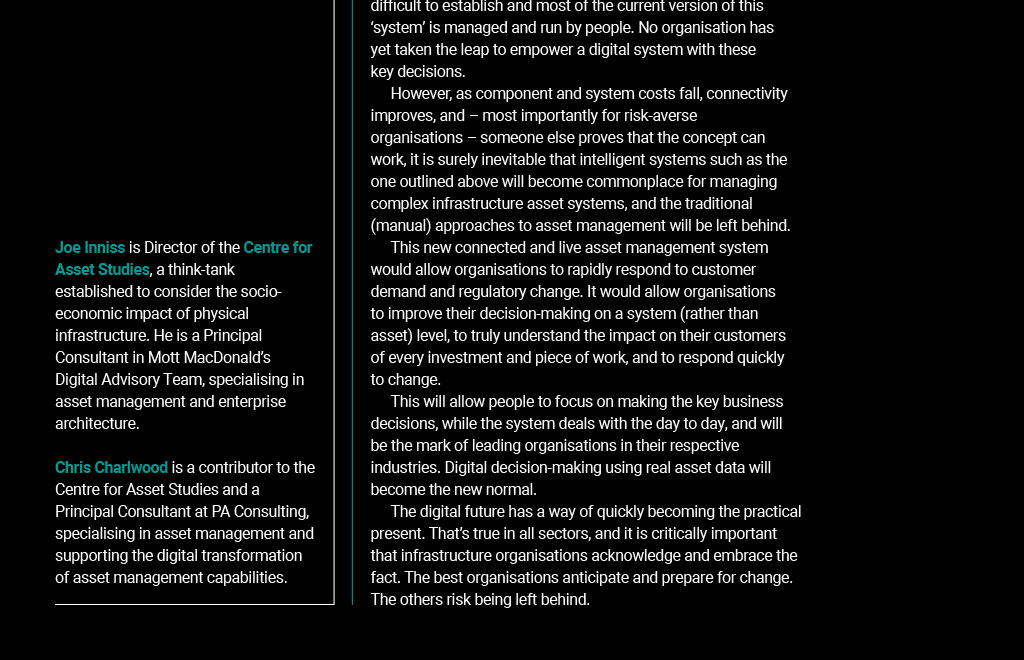




Opinion A digital future Coinciding with their paper to be published by the Centre of Asset Studies, Chris Charlwood and Joe Inniss look at how digital disruption is transforming physical asset management Joe Inniss Chris Charlwood S ince humans first discovered fire, it has been obvious that technology is fundamental to who we are and what we, as a species, can achieve. In the 21st century, this has never been truer and, arguably, the most significant technology changes have occurred around the use and rapid expansion of digital systems. Asset management, the coordination of an organisations activities to maximise value from its assets, is not immune from this digital change. Over the past 30 years, asset-intensive infrastructure organisations have been investing in technology to better manage their physical assets. This has frequently been piecemeal, as funds are often restricted and the need limited to specific target areas. For example, digital work management systems have been introduced to coordinate maintenance activities, along with decision-support tools to help prioritise investment for regulatory business plans. Traditionally, these have been discrete systems, with the only links between them being human meaning that analysis and the linked decision-making are still largely manual processes, even for the most advanced organisations. A smart world Digital decisionmaking using real asset data will become the new normal Joe Inniss is Director of the Centre for Asset Studies, a think-tank established to consider the socioeconomic impact of physical infrastructure. He is a Principal Consultant in Mott MacDonalds Digital Advisory Team, specialising in asset management and enterprise architecture. Chris Charlwood is a contributor to the Centre for Asset Studies and a Principal Consultant at PA Consulting, specialising in asset management and supporting the digital transformation of asset management capabilities. We can imagine a near future where assets are smart enough to report their condition on a regular basis and can flag when their condition has degraded to the point where performance will soon be impacted, so that a maintenance intervention is arranged automatically. This would be collected by the intelligent company-wide digital asset manager system, which would collate asset data from around the asset base and change various parameters to optimise performance within the live, cognitive digital twin, to deal with customer and network demands. This same system could also optimise a programme of asset work to predict any failure long before it occurs, to maintain a high standard of service to the customer by adjusting the whole asset system (including operational parameters) and ensure that the programme fits within the constraints set by company investors, by the company strategy and by the industry regulator. This same system could schedule in work orders for maintenance teams to complete and packages of larger works to be sent to framework contractors for delivery. Robust decision-making, with clear audit trails throughout and all in real time. Making the links This kind of system isnt far away from reality most of this technology already exists on the market, but not as a full, integrated system. Linkages between each component are difficult to establish and most of the current version of this system is managed and run by people. No organisation has yet taken the leap to empower a digital system with these key decisions. However, as component and system costs fall, connectivity improves, and most importantly for risk-averse organisations someone else proves that the concept can work, it is surely inevitable that intelligent systems such as the one outlined above will become commonplace for managing complex infrastructure asset systems, and the traditional (manual) approaches to asset management will be left behind. This new connected and live asset management system would allow organisations to rapidly respond to customer demand and regulatory change. It would allow organisations to improve their decision-making on a system (rather than asset) level, to truly understand the impact on their customers of every investment and piece of work, and to respond quickly to change. This will allow people to focus on making the key business decisions, while the system deals with the day to day, and will be the mark of leading organisations in their respective industries. Digital decision-making using real asset data will become the new normal. The digital future has a way of quickly becoming the practical present. Thats true in all sectors, and it is critically important that infrastructure organisations acknowledge and embrace the fact. The best organisations anticipate and prepare for change. The others risk being left behind.